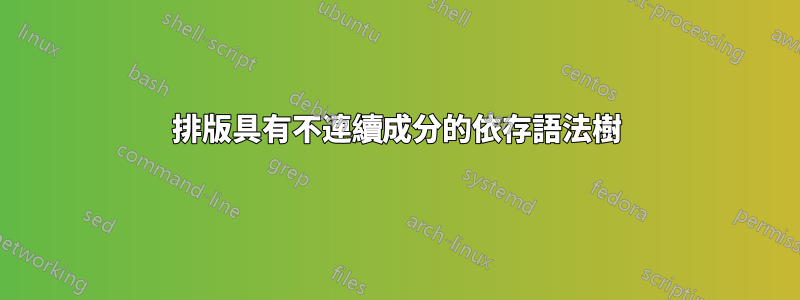
我設法排版簡單的依存語法樹(排版依存語法樹),但現在想要有非投影圖。解決方案forest如下:
\documentclass{article}
\usepackage{forest}
\forestset{
dg edges/.style={for tree={parent anchor=south, child anchor=north,align=center,base=bottom,where n children=0{tier=word,edge=dotted,calign with current edge}{}}},
}
\begin{document}
\begin{forest}
dg edges
[V
[N, phantom,no edge
[L1, phantom,no edge
[L2, phantom,no edge
[L3, phantom,no edge [ N,name=nacc [wen\\who] ] ] ] ] ]
[glaubst\\believes]
[N [du\\you] ]
[Subjunction
[dass\\that]
[V-fin
[V-prt, name=vprt
[N [ich\\I ] ]
[gesehen\\seen] ]
[habe\\have] ] ] ]
\draw (vprt.south)--(nacc.north);
\end{forest}
\end{document}
這會產生下圖:

我用虛擬節點填充了空樹位置並添加了這些虛擬no edge節點,以便這些虛擬節點沒有連接。另外,我用手從vprt到畫了一條線。nacc
差不多就這些了,但是我有兩個問題:
這樣可以做得更好(更簡單)嗎?
兩個N的對齊有問題。最左邊的 N 比右邊的 N 高。有沒有辦法讓它們在同一條線上?這種差異是由於幻影沒有高度造成的嗎?
答案1
您不需要no edge另外phantom。您可以使用另一個選項對齊兩個 N tier:
\documentclass{article}
\usepackage{forest}
\forestset{
dg edges/.style={%
for tree={%
parent anchor=south,
child anchor=north,
align=center,
base=bottom,
where n children=0{%
tier=word,
edge=dotted,
calign with current edge}{}
}
},
}
\begin{document}
\begin{forest}
dg edges
[V
[N, phantom
[L1, phantom
[L2, phantom
[L3, phantom [N, name=nacc, tier=mytier [wen\\who] ] ] ] ] ]
[glaubst\\believes]
[N [du\\you] ]
[Subjunction
[dass\\that]
[V-fin
[V-prt, name=vprt
[N, tier=mytier [ich\\I ] ]
[gesehen\\seen] ]
[habe\\have] ] ] ]
\draw (vprt.south)--(nacc.north);
\end{forest}
\end{document}



